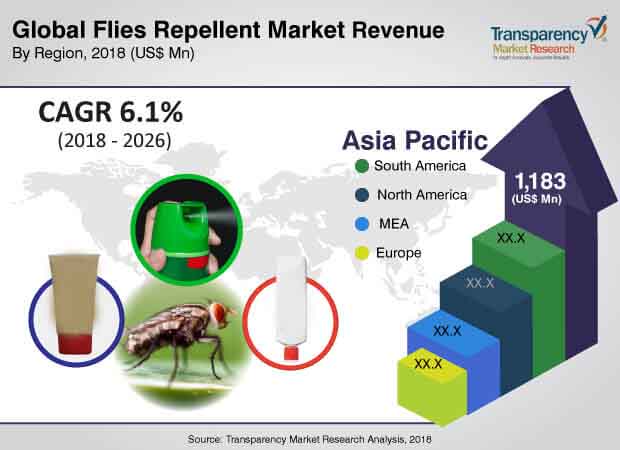Flies Repellent Market: Key Development Opportunities Hidden In Emerging Economies 2018 - 2026
According to a new market report published by Transparency Market Research titled ‘Flies Repellent Market – Global Industry Analysis, Size, Share, Growth, Trends, and Forecast, 2018 – 2026, the global flies repellent market is expected to reach US$ 3,724.5 Mn by 2026, expanding at a CAGR of 6.1% from 2018 to 2026. In terms of volume, the market is expected to reach 3,656,490 thousand units by 2026, expanding at a CAGR of 5.7% from 2018 to 2026. Asia Pacific was the single largest fly repellent market by region in 2017 and its market share is expected to increase during the forecast period.
Flies repellent containing synthetic active ingredients dominated the market in 2017 and the trend is expected to continue during the forecast period. Synthetic active ingredients are more common than natural active ingredients as there is data present in various organizations such as EPA (Environmental Protection Agency) and Centers for Disease Control and Prevention (CDC) that prove the effectiveness of synthetic active ingredients compared to natural active ingredients. EPA has only tested the safety of natural active ingredients and not their effectiveness.

Request PDF Brochure – https://www.transparencymarketresearch.com/sample/sample.php?flag=B&rep_id=52722
Leishmaniasis which is a disease caused by bite from sand flies is increasing in the U.S. according to the Infectious Diseases Society of America (IDSA). With rise in outdoor recreation activities and ecotourism in the U.S. there is an increase in the number of soldiers and travelers infected with leishmaniasis which is caused by sand flies. Although leishmaniasis is an uncommon disease in the U.S. and North American countries, the number of persons affected by it is rising. This is increasing the demand for flies repellent in the U.S. and other North American countries.
Leishmaniasis is increasing in Europe as well. Leishmaniasis is of three types: visceral, cutaneous, and mucocutaneous. As per WHO, visceral leishmaniasis is endemic in the following European countries: Portugal, Spain, France, Italy, Slovenia, Croatia, Bosnia and Herzegovina, Montenegro, Albania, Greece, Macedonia, Bulgaria, Ukraine, Moldova, Georgia, etc. Thus, rise in leishmaniasis is expected to increase the demand for flies repellent products in Europe.
In 2015, as per WHO, cutaneous leishmaniasis cases were most reported from Iran, Pakistan, Afghanistan, and other Asia Pacific countries. In 2015, in Iran, the number of reported cutaneous leishmaniasis was 908 which is highest in the world. Visceral leishmaniasis, which is another type of leishmaniasis caused by biting of sand flies is prevalent in China, India, Thailand, and other Asia Pacific countries. Rising number of leishmaniasis cases is driving the demand for flies repellent products in Asia Pacific as no vaccine for the disease is available.
In Middle East & Africa (MEA), there is an increasing participation of people including women going outdoors for jobs and other activities. They are aware of fly related diseases and prefer to use cream and oil repellent products to protect themselves when they are outdoor. Sprays/ aerosols are also seeing increasing demand as they are more effective in repelling flies than other forms of repellents.
Comments
Post a Comment